8.8 Client Ambulation Using Assistive Devices
Immobility in hospitalized clients is known to cause functional decline and complications affecting the respiratory, cardiovascular, gastrointestinal, integumentary, musculoskeletal, and renal systems (Kalisch, Lee, & Dabney, 2013). For surgical clients, early ambulation is the most significant factor in preventing complications (Sanguinetti, Wild, & Fain, 2014). Lack of mobility and ambulation can be especially devastating to the older adult when the aging process causes a more rapid decline in function (Graf, 2006). Ambulation provides not only improved physical function, but also improves emotional and social well-being (Kalisch, Lee, & Dabney, 2013).
Prior to assisting a client to ambulate, it is important to perform a point-of-care risk assessment to determine how much assistance will be required. This assessment evaluates a client’s muscle strength, activity tolerance, and ability to move, as well as the need to use assistive devices or find additional help. The amount of assistance will depend on the client’s condition, length of stay and procedure, and any previous mobility restrictions.
Before ambulating, the client may need assistance getting to a sitting position.
Assisting Client to the Sitting Position
Clients who have been immobile for a long period of time may experience vertigo, a sensation of dizziness, and orthostatic hypotension, a form of low blood pressure that occurs when changing position from lying down to sitting, making the client feel dizzy, faint, or lightheaded (Potter et al., 2017). For this reason, always begin the ambulation process by sitting the client on the side of the bed for a few minutes with legs dangling. Checklist 8.8.1 outlines the steps to positioning the client on the side of a bed prior to ambulation (Perry et al., 2018).
Checklist 8.8.1: Assisting a Client to a Sitting Position
Disclaimer: Always review and follow your agency policy regarding this specific skill.
Safety considerations:
- Perform hand hygiene.
- Check room for additional precautions.
- Introduce yourself to client.
- Listen and attend to client cues.
- Ensure client’s privacy and dignity.
- Complete the point-of-care risk assessment for safer client handling.
- Ensure tubes and attachments are properly placed prior to the procedure to prevent accidental removal.
- Follow the principles of proper body mechanics with all client-handling procedures.
| STEP | ACTION | ADDITIONAL INFORMATION |
|---|---|---|
| 1. | Ensure the client is wearing proper footwear and you have the necessary equipment.
Check prescriber’s orders for any restrictions related to ambulation due to medical treatment or surgical procedure. |
Equipment (proper footwear, gait belt, or assistive devices) must be gathered prior to ambulation. Do not leave client sitting on the side of the bed unsupervised, as this poses a safety risk. |
| 2. | Explain what will happen and let the client know how they can help. | This step provides the client with an opportunity to ask questions and help with the positioning. |
| 3. | Lower bed and ensure brakes are applied. | This prepares the work environment. |
| 4. | Stand facing the head of the bed at a 45-degree angle with your feet apart, with one foot in front of the other. Stand next to the waist of the client. | Proper positioning helps prevent back injuries and provides support and balance. |
| 5. | Have the client turn onto side, facing toward the caregiver. Assist the client to move close to the edge of the bed. | Turning, rolling, and leverage requires less work than lifting. This step prepares the client to be moved.
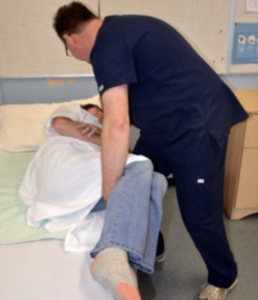 |
| 6. | Place one hand behind the client’s shoulders, supporting the neck and vertebrae. | This provides support for the client.
If available, use the electric bed to elevate the client’s torso to a sitting position. |
| 7. | On the count of three, instruct the client to use their elbows to push up on the bed and then grasp the side rails, as you support the shoulders as the client sits up. Shift weight from the front foot to the back foot. | Do not allow the client to place their arms around your shoulders. This action can lead to serious back injuries. |
| 8. | At the same time as you’re shifting your weight, gently grasp the client’s outer thighs with your other hand and help the client slide their feet off the bed to dangle or touch the floor. | This step helps the client sit up and move their legs off the bed at the same time.
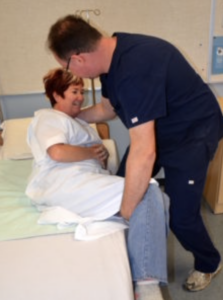 |
| 9. | Bend your knees and keep your back straight and neutral. | Use of proper body mechanics helps prevent injury when handling clients. |
| 10. | On the count of three, gently raise the client to sitting position. Ask the client to push against bed with the arm closest to the bed, at the same time as you shift your weight from the front foot to the back foot. | This allows the client to help with the process and prevents injury to the health care provider.
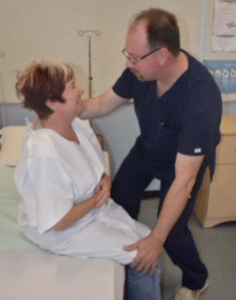 |
| 11. | Observe and evaluate the client for orthostatic hypotension or vertigo. | If client is not dizzy or lightheaded, the client is safe to ambulate.
If client becomes dizzy or faint, lay client back down on bed. |
| 12. | Continue with mobilization procedures as required. | Mobilization helps prevent complications and improves physical function in hospitalized clients. |
Assisting a Client to Ambulate
Ambulation is defined as walking a client from one place to another (Potter et al., 2010). Once a client is assessed as safe to ambulate, the nurse must determine if assistance from additional health care providers or assistive devices is required.
The following checklists provide guidance in assisting to ambulate using a gait belt or transfer belt (see Checklist 8.8.2), walker (Checklist 8.8.3), crutches (Checklist 8.8.4), and a cane (Checklist 8.8.5).
Checklist 8.8.2: One-Person Assist Using Gait / Transfer Belt
Disclaimer: Always review and follow your agency policy regarding this specific skill.
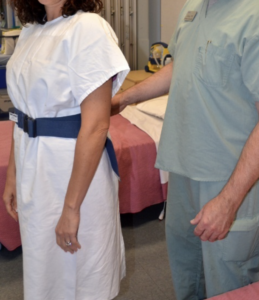
Safety considerations:
- Perform hand hygiene.
- Check room for additional precautions.
- Introduce yourself to the client.
- Listen and attend to client cues.
- Ensure client’s privacy and dignity.
- Complete the point-of-care risk assessment for safer client handling.
- Ensure tubes and attachments are properly placed prior to the procedure to prevent accidental removal.
- The gait belt should fit snug and not tight around the client’s waist.
| STEP | ACTION | ADDITIONAL INFORMATION |
|---|---|---|
| 1. | Ensure the client does not feel dizzy or lightheaded and is tolerating the upright position.
Check physician’s orders for any activity restrictions related to treatment or surgical procedures. |
|
| 2. |
Ensure the client is wearing proper footwear. Let client know how far you will be ambulating. Position or instruct the client to sit on the edge of the bed or chair with their feet flat on the floor and slightly apart, prior to ambulation.
|
Proper footwear is non-slip or slip-resistant footwear. Socks are not considered proper footwear. Proper footwear is essential in preventing accidental falls.
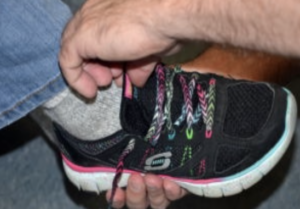 |
| 3. | Explain to the client what will happen and what they can do to help.
Apply gait belt snugly around the client’s waist; be sure not to apply the belt directly over the client’s skin but rather over their clothes. If the transfer is to a wheelchair, be sure to have the wheelchair in close position and brakes locks engaged. |
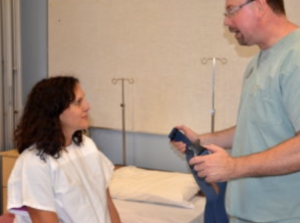 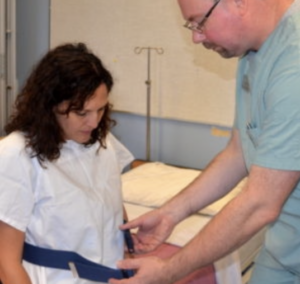 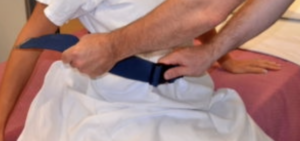 |
| 4. | Reach across the client’s back and grasp onto the transfer belt.
Ask the client to lean their upper body forward so their nose is over their toes. |
The client must be cooperative and predictable, able to bear weight on own legs, and have good trunk control.
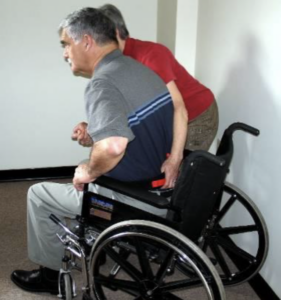 If the client is unable to carry out these actions, this may indicate a change in their ability; or if you feel you are at risk of injury with this client, contact the clinician or your supervisor for advice. |
| 5. | Use a thumb-to-thumb grasp, place your right hand (palm up) into the client’s right hand (palm down) or left if on opposite side. |
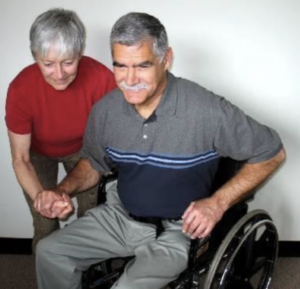 |
| 6. | Ask the client to lean forwards and stand, providing guidance with the pressure of your arm and hand in a forward direction—not lifting up.
Caution is required when asking a client to reach back to the armrest. It may help them to support their weight as they sit; however, this may allow their trunk to lean too far back, throwing them—and you—off balance. Ensure you are prepared for this the first time you work with this client. |
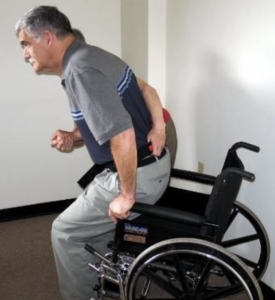 Keeping the client’s weight forward as they sit will put you at less risk of overbalancing, taking too |
| 7. | If you are planning on ambulating with the client. Once the client is standing and feels stable, grasp the gait belt in the middle of the back. Remain at their side to provide support with your hip and hand grasp. Only move away from the chair once you are sure the client can balance. |
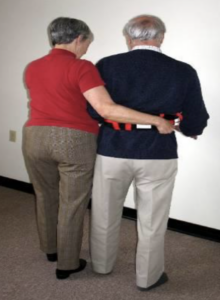 Standing to the side of the client provides assistance without blocking the client. |
| 8. | To help a client back to bed or sitting, have client stand with back of knees touching the bed or chair. Grasp the gait/transfer belt, again as per the directions in step #3 above.
When finished, remove the gait/transfer belt and settle the client. |
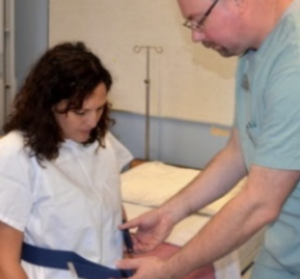 Keeping the client’s weight forward as they sit will put you at less risk of overbalancing, taking too much of the weight and being injured. |
| 9. | Leave the client in a safe place. If in bed, place the bed in lowest position, raise side rails as required, and ensure call bell is within reach. Perform hand hygiene. | Placing bed and side rails in a safe position reduces the likelihood of injury to client. Proper placement of call bell facilitates client’s ability to ask for assistance.
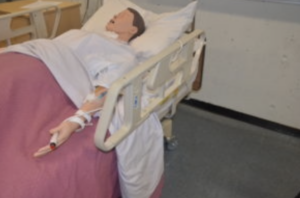 Bed in the lowest position, call bell in reach, and side rail up Hand hygiene reduces the spread of microorganisms. |
| 10. | Document the client’s ability to tolerate ambulation and type of assistance required. Update the care plan as required. | This provides a baseline of the client’s abilities and promotes clear communication between health care providers. |
Watch the video:
Ambulate with Gait Belt (2018) by Kim Morris of Thompson Rivers University School of Nursing on how to ambulate using a gait belt.
Checklist 8.8.3: Ambulating with a Walker
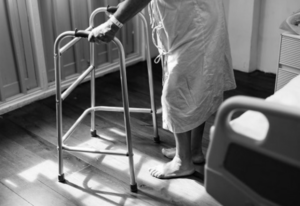
Disclaimer: Always review and follow your agency policy regarding this specific skill.
Safety considerations:
- Perform hand hygiene.
- Check room for additional precautions.
- Introduce yourself to the client.
- Listen and attend to client cues.
- Ensure client’s privacy and dignity.
- Complete the point-of-care risk assessment for safer client handling.
- Ensure proper fitting footwear.
- Use rubber tips to prevent the device from slipping.
- Avoid scatter rugs.
- Inspect rubber ends after being outside and remove any gravel.
| STEP | ACTION | ADDITIONAL INFORMATION |
|---|---|---|
| 1. | Ensure the client is wearing proper footwear.
Let the client know how far you will be ambulating. If in acute care, check prescriber’s orders for any activity restrictions related to treatment or surgical procedures. |
Proper footwear is non-slip or slip-resistant footwear. It is is essential to prevent accidental falls.
An informed client is part of delivering safe client care. 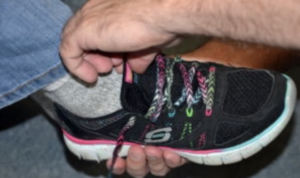 |
| 2. | Measure client for walker height. |
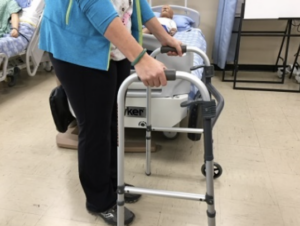 The top of the walker should line up with the crease on the inside of the wrists when one is standing. Elbows should flex 15–30 degrees when standing inside the walker with hands on the hand grips. |
| 3. | Explain and demonstrate how to walk with a walker. |
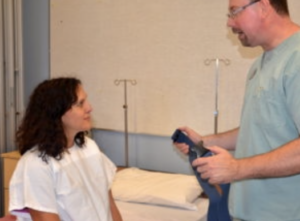 |
| 4. | From a sitting position, instruct client to push up from the chair’s armrest to a standing position. | Do not use the walker to pull oneself up. It is not stable and could result in injury.
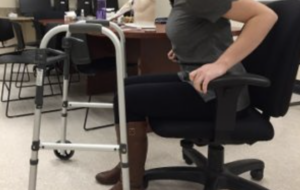 Apply gait belt if required for additional support. |
| 5. | Firmly grip both sides of the walker.
Move the walker forward a short distance. |
The base of the walker provides a broad base of support.
Once client is standing and feels stable, move to the unaffected side. If using a gait belt, grasp the belt in the middle of the client’s back. |
| 6. | Ask client to step forward with the injured or weak leg first, taking the weight through their hands.
Then ask them them step with the stronger leg. |
Do not step forward if all four feet of the walker are not in contact with the floor.
Walker – weak leg – strong leg. Keep feet within the walker’s boundaries. Advise the client to look forward not down at the floor. |
| 7. | To turn, advise to take small steps, moving the walker and then the legs. | Avoid twisting the knee joint when turning. Walking in a large circle may be necessary. |
Checklist 8.8.4: Ambulating with Crutches
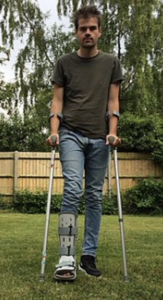 |
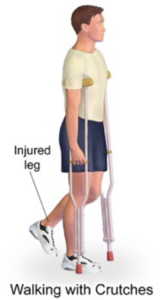 |
Disclaimer: Always review and follow your agency policy regarding this specific skill.
Safety considerations:
- Perform hand hygiene.
- Check room for additional precautions.
- Introduce yourself to client.
- Listen and attend to client cues.
- Ensure client’s privacy and dignity.
- Complete the point-of-care risk assessment safer client handling.
- Ensure proper fitting footwear.
- Use rubber tips to prevent the device from slipping.
- Avoid scatter rugs.
- Inspect rubber ends after being outside and remove any gravel.
- Ensure tubes and attachments are properly placed prior to the procedure to prevent accidental removal.
| STEP | ACTION | ADDITIONAL INFORMATION |
|---|---|---|
| 1. | Ensure the client is wearing proper footwear.
Let the client know how far you will be ambulating. If in acute care, check prescriber’s orders for any activity restrictions related to treatment or surgical procedures. |
Proper footwear is essential to prevent accidental falls.
An informed client is part of delivering safe client care.  |
| 2. | Ensure crutch height is correct. | Axilla height crutches: When standing, the there should be two to three finger widths from the axilla to the top of the crutch. The height of the hand grip will be adjusted to allow the elbow to be flexed 15–30 degrees or to the wrist crease. There are different crutch walking techniques that depend on the client’s ability to bear weight.
Forearm crutches: The elbows should be flexed 15–30 degrees when holding the hand grips. The forearms should be supported roughly mid-point between the wrist and elbow. |
| 3. | Explain and demonstrate how to walk with crutches. | An informed client may result in reduced risk of falls. |
| 4. | From a sitting position, advise the client to push up from the chair’s armrest to a standing position. Stand to gain balance. Advise the client to not lean on the underarm supports. | The client should be cooperative and predictable, able to bear weight on own legs, and to have good trunk control. Apply gait belt if required for additional support.
Pressure on the axilla can cause damage to tissues and nerves. |
| 5a. | Ambulation method #1
Advise client to do the following:
|
Bear in mind any weight bearing limitations. |
| 5b. | Ambulation method #2
Advise client to do the following:
|
Ambulation method #2 requires good balance and trunk strength. |
| 6a. | Ascending stairs
Advise client to do the following:
|
Strong leg – weak leg – crutches.
Use of the handrail may be helpful. |
| 6b. | Descending stairs
Advise client to do the following:
|
Crutches – weak leg – strong leg.
Use of the handrail may be helpful. |
Watch the video:
Ambulate with Crutches (2018) by Kim Morris of Thompson Rivers University School of Nursing on how to ambulate with crutches.
Checklist 8.8.5: Ambulating with a Cane
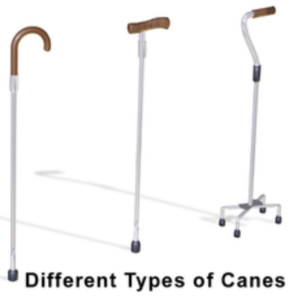
Disclaimer: Always review and follow your agency policy regarding this specific skill.
Safety considerations:
- Perform hand hygiene.
- Check room for additional precautions.
- Introduce yourself to client.
- Listen and attend to client cues.
- Complete the point-of-care risk assessment for safer client handling.
- Ensure proper fitting footwear.
- Use rubber tips to prevent the device from slipping.
- Avoid scatter rugs.
- Inspect rubber ends after being outside and remove any gravel.
- Ensure tubes and attachments are properly placed prior to the procedure to prevent accidental removal.
| STEP | ACTION | ADDITIONAL INFORMATION |
|---|---|---|
| 1. | Ensure the client is wearing proper footwear.
If in acute care, check prescriber’s orders for any activity restrictions related to treatment or surgical procedures. Let the client know how far you will be ambulating.
|
Proper footwear is non-slip or slip-resistant footwear. It is is essential to prevent accidental falls.
An informed client is part of delivering safe client care.  |
| 2. | Ensure cane height is correct. | Cane height is the length from the greater trochanter to the floor. Allow 15–30-degree flexion at the elbow. |
| 3. | Explain and demonstrate how to walk with crutches. | An informed client may result in reduced risk of falls. |
| 4. | Encourage the client to get to a standing position. | Quad cane: Push up from the armrest of the chair to standing position. Grasp cane and establish balance.
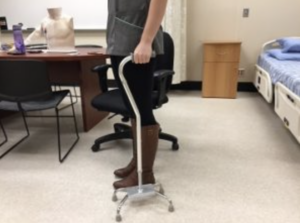 Standard cane: Hold the cane handle in one hand. Push up from the armrest to standing position. Establish balance. |
| 5. | Advise the client to move the cane forward a short distance. | Cane position is forward and slightly to the side when ambulating. |
| 6. | Step forward with injured / weak leg. Put weight onto the cane handle. Then step with the strong leg. | Cane – weak leg – strong leg. |
| 7a. | Ascending stairs
Advise client to do the following:
|
Strong leg – weak leg – cane.
Quad canes may have to be turned sideways to fit on a stair. Use of handrail may help improve balance. |
| 7b. | Descending stairs
Advise client to do the following:
|
Watch the video:
Ambulate with cane (2018) by Kim Morris of Thompson Rivers University School of Nursing on how to ambulate with a cane.
Critical Thinking Exercises
- A 90-year-old client is required to ambulate. He had a total hip arthroplasty and is post-operative day 2. What risk factors should be considered prior to ambulating an older client who has been immobile after hip surgery?
- Does ambulation require an order from a prescriber?
- What should you do if a client feels dizzy or lightheaded before ambulation?
- Data sources: Interior Health, 2013; Perry et al., 2018; PHSA, 2010. Images retrieved from 3.6 Assisting a Patient to a Sitting Position and Ambulation in Clinical Procedures for Safer Patient Care by Glynda Rees Doyle and Jodie Anita McCutcheon, CC BY 4.0 ↵
- Data sources: Interior Health, 2013; Perry et al., 2018; PHSA, 2010. Images retrieved from 3.6 Assisting a Patient to a Sitting Position and Ambulation in Clinical Procedures for Safer Patient Care by Glynda Rees Doyle and Jodie Anita McCutcheon, CC BY 4.0 ↵
- Data sources: Cleveland Clinic, 2018a; Perry et al., 2018. Images retrieved from 3.10 Assisting a Patient to Ambulate Using Assistive Devices in Clinical Procedures for Safer Patient Care - TRU Edition by Renée Anderson, Glynda Rees Doyle, and Jodie Anita McCutcheon, CC BY 4.0 ↵
- Data sources: Cleveland Clinic, 2018b; Perry et al., 2018 ↵
- Data sources: Cleveland Clinic, 2018c; Perry et al., 2018. Images retrieved from 3.10 Assisting a Patient to Ambulate Using Assistive Devices in Clinical Procedures for Safer Patient Care - TRU Edition by Renée Anderson, Glynda Rees Doyle, and Jodie Anita McCutcheon, CC BY 4.0 ↵
A sensation of whirling in which an individual or the individual’s environment is spinning, making the individual feel dizzy
Low blood pressure that causes dizziness, light-headedness, and even fainting when one goes from a lying or sitting position to a standing position. Also called postural hypotension.
The act of moving or walking a client from one place to another. Once a client is assessed as safe to ambulate, the nurse must determine if assistance from additional health care providers or assistive devices is required.

